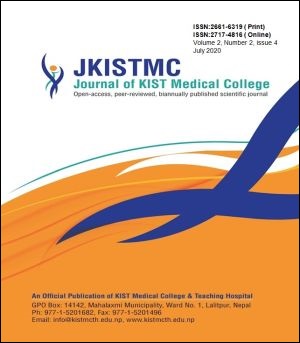Efficacy of The Subcostal Transversus Abdominis Plane Block In Laparoscopic Cholecystectomy: A Comparison With Conventional Port- Site Infiltration
DOI:
https://doi.org/10.3126/jkistmc.v2i2.33578Keywords:
Laparoscopic Cholecystectomy, Subcostal TAP Block, Post-Operative Analgesia, Visual Analogue Scale (VAS)Abstract
Introduction: Pain experienced following laparoscopic cholecystectomy derives significantly from incision made in anterior abdominal wall. Many patients experience moderate to severe pain following laparoscopic cholecystectomy. This study aimed to compare the efficacy of ultrasound guided bilateral subcostal transversus abdominal plane (TAP) block with port-site infiltration for post-operative analgesia after laparoscopic cholecystectomy.
Methods: Sixty patients undergoing laparoscopic cholecystectomy were randomly allocated to two groups to receive port-site infiltration of local anaesthesia or ultrasound guided subcostal TAP block at the end of surgery before extubation. All patients received 1 gm paracetamol intravenously 8 hourly. Post-operative pain was assessed using visual analogue score at 0,1,2,4,8,16 and 24 hours. Time to first analgesic requirement and total opioid consumption over 24 hours were recorded.
Results: Ultrasound guided bilateral subcostal transversus abdominis plane block significantly reduced post-operative pain score compared to port site infiltration. We observed statistically significant differences in visual analogue score between two groups at all other time frame. The 24 hours opioid consumption was less in Subcostal TAP (136±66.31μg VS 202±80.58μg, p=0.001). Time for rescue analgesia was prolonged in patient receiving subcostal TAP (3.63±2.09 hrs VS 1.73±1.60 hrs, p=0.0002).
Conclusion: Ultrasound guided bilateral subcostal transversus abdominal block provides superior post-operative analgesia and reduced opioid consumption after laparoscopic cholecystectomy compared to port-site infiltration.

